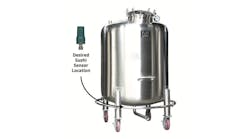Wireless communication technology in process knowledge systems offers direct cost savings over more traditional communications media. Innovative use of mobile and remote applications can improve business results for today's chemical processing facilities. Those facilities that deploy wireless technology first will have a competitive advantage in the marketplace.
Mobile productivity
In a typical chemical production facility, keeping the plant at maximum production requires the best use of a diverse set of skills, expertise and functional disciplines. Major functional disciplines include operations, maintenance and engineering. See Table 1.
Process Knowledge System Topology
Traditional distributed control systems (DCSs) and field-based control systems use very different databases to support the functional requirements of the individual disciplines and sub-disciplines. For example, although a good DCS would deliver an exceptional set of tools for the control room board operator (e.g., operator graphics), it would provide nothing to automate the work processes of the field operator.
These diverse, nonintegrated applications increase installation costs, raise maintenance costs and are ultimately detrimental to the health and safety of plant personnel.
Today's chemical facilities also struggle with a shrinking workforce. Competitive cost constraints mean plants have fewer specialists to manage today's increasingly complex systems and sub-systems.
Operations needs
The control room board operator's job often has been described as 99 percent boredom and one percent sheer terror. His or her tasks typically include monitoring, troubleshooting, problem mitigation and ad-hoc functions. A field operator's jobs typically involve procedural, routine tasks such as operator rounds, data collection, visual inspections, manual operations, maintenance work order preparation and radio and paper reporting of information.
Maintenance needs
Maintenance functions also include both ad-hoc and procedural types of activities. Functions such as troubleshooting and repair require easy access to context-sensitive information and collaborative workforce environments. Procedural operations such as calibration and testing typically require large amounts of data to be input and validated ," often in remote and even hazardous environments.
Engineering needs
For engineering, remote access and mobile access of day-to-day office and engineering tools are becoming more important. These information needs apply whether knowledge workers are down the hall in a conference room during a meeting or at the top of the platform reviewing the process trends for a particular tower.
Team-based opportunity
Process knowledge systems expand the scope of automation by using wireless technology to deploy mobile productivity solutions. These solutions unify the impact, work flow, work processes, databases, applications and tool sets of the various disciplines needed to ensure plant productivity. They provide accurate data from the process ," data that now are integrated automatically into the expanded control system. See Table 2.
A collaborative decision support environment exists between the field and the control room, assisting in incident reduction and avoidance and improving production uptime.
For example, work process management software can be carried around on a hand-held wireless computer to perform operator rounds, data collection, inspections, etc. The rounds can be scheduled automatically and downloaded from the process knowledge system. Instruments can be identified, and the data collected can be validated through the use of radio frequency identification (RFID) tags. The collected data then can be uploaded automatically from the field for use by the system, control room operator and electrical & instrumentation (E&I) technician. Supplemental data on equipment ," such as material safety data sheets (MSDS) and operating instructions ," can be accessed in an asset-centric and context-sensitive manner to reduce work and waste.
The same application, infrastructure and equipment can be used by the maintenance technician when calibrating field instrumentation. The E&I technician can go out to the field and set up a standard input to do a calibration. He then can command a method remotely (to calibrate the high end or the low end, for example) and automatically capture the calibration information, sending it back electronically to the single process knowledge system database. This capability now means a single person can perform a task that previously required multiple people, making ongoing maintenance, turnarounds and initial system start-up faster and more cost-effective.
Enabling asset management
Currently, most processes are instrumented for process control and operations purposes. The high cost of installing field instrumentation many times prohibits the purchase of the additional sensors and data points needed for superior equipment monitoring and plant asset management.
Mobile productivity solutions enable frequent collection of data that are difficult to obtain from traditional sources. Also, the field operator can reliably record visual field observations and the status of the process and equipment, and input them directly into the process knowledge system. This additional data and information, previously not integrated into the system, enables proactive asset management and best-in-class maintenance systems.
Remote low-cost sensors
Hundreds of thousands of meters of instrumentation wiring and cable typically are strewn throughout a chemical manufacturing facility. Digital smart field buses scratch only the surface of the potential cost savings in wiring reduction.
The main benefits that can be derived from wireless communication media include a reduction of wiring and installation of control systems in industrial process plants; improved speed at which these control systems can be engineered, configured and installed; and reduced ongoing maintenance costs. Remote communication savings are particularly attractive in greenfield installations to reduce the cost of new instrumentation wiring. They also can be used in revamps and modernization projects to reduce the cost of additional field instrumentation.
The installed cost of instrumentation can be quite high, and much of that cost is in the wiring back to the control system. The wiring cost, labor cost and cost of adding additional input/output (I/O) to the control system represents a significant commitment in the form of investment; therefore, plant personnel:
Tend to measure and collect the bare minimum set of process variables.
Tend to "overbuild" (in the form of bullet-proofing and "gold-plating") the devices in the field.
The secondary set of behaviors these investment drives spur is embodied in the ever-expanding set of parameters, values and algorithms embedded in smart field devices ," hundreds per transmitter in some cases. Because the investment is so high, plants struggle to do anything that can protect and deliver more value with that investment.
With the adoption and combination of micro-electro-mechanical systems (MEMS) and wireless technologies, a new paradigm is emerging. This new paradigm makes previous traditional field devices and field-centric control system approaches obsolete, and makes sensors and their installation, calibration and commission via wireless technologies relatively inexpensive. Low- cost wireless sensors and bus technologies are the harbinger of significant and real cost savings in plant construction, operation and maintenance.
Many significant hurdles and barriers still exist to the adoption of wireless field devices (one area of concern is robustness and safety), but many of these problems are being resolved. For example, at least one supplier provides a fail safe controller (FSC) that has, for several years, employed a fail safe safety network that is TUV approved for SIL3 safety applications using standard off-the-shelf communications technologies, including wireless communication.
Wireless delivers results
Process knowledge systems that employ wireless technologies in specific application areas innovatively can deliver improved results to chemical processing facilities today. Wireless technologies offer mobile productivity solutions. Together with remote, low-cost sensors, these technologies will deliver added value to the industry as the adoption rate improves and the technology becomes mature.
Hillman works for Honeywell's TPS systems business, new system development, and safety management systems. He is a TUV-Certified Functional Safety Expert (CFSE) and is manager, Asset and Abnormal Situation Management Marketing for Honeywell Industry Solutions, Phoenix. Contact him at [email protected].


